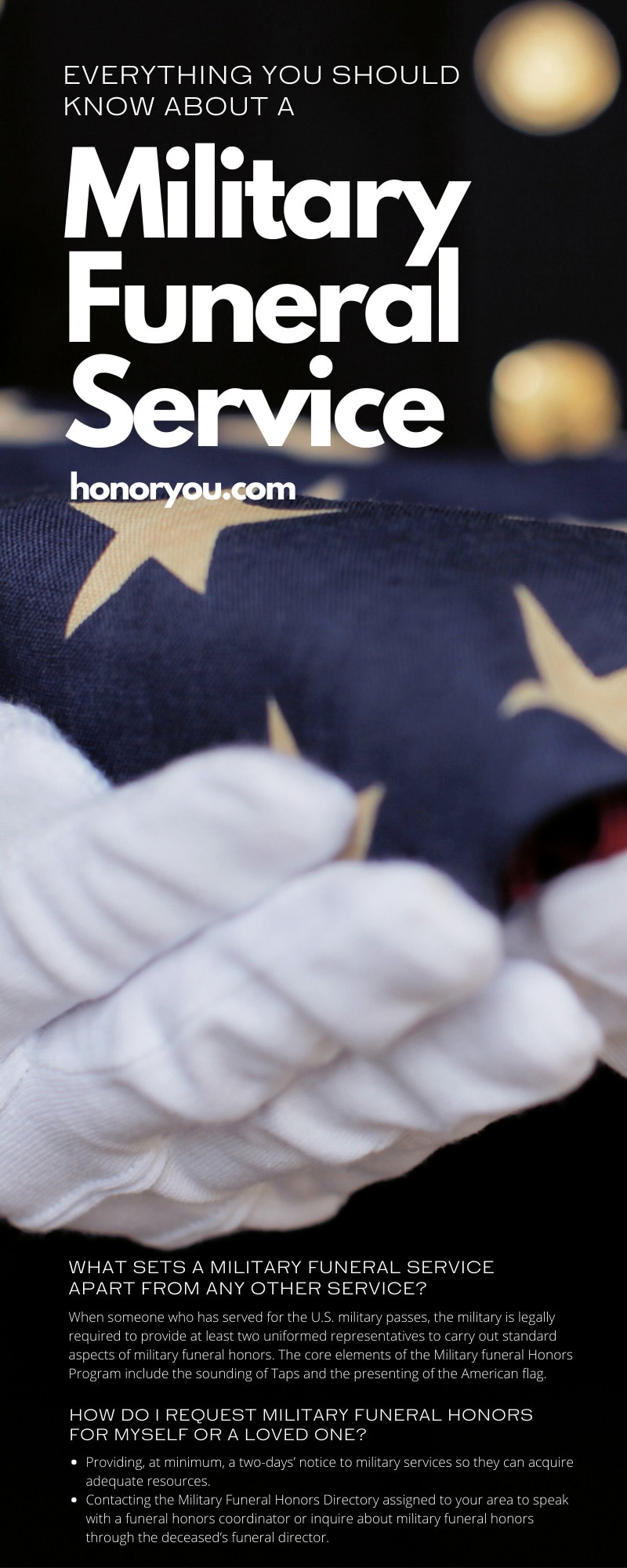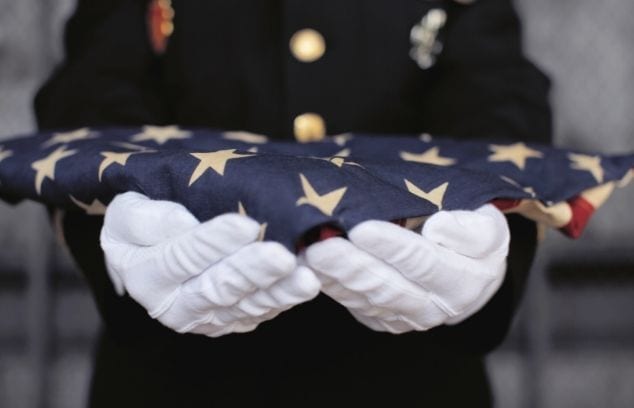Everything You Should Know About a Military Funeral Service

How To Make a Memorial Shadow Box
May 19, 2021
Signs That It’s Time To Seek Grief Counseling
June 9, 2021Traditional funeral services have standard procedures to help commemorate the life of the deceased in an orderly fashion. While funeral services for military personnel typically maintain a similar order of operations, they also include a variety of additional formalities that set them apart from traditional funerals. The additional procedures and notably formal nature of military funerals is intended to honor the courage, commitment, and selflessness of the deceased’s service. If you are inquiring about a military funeral service to secure your own final arrangements or learning for a recently deceased loved one who served, Honor You provides everything you should know about a military funeral service below.
What Sets a Military Funeral Service Apart From Any Other Service?
When someone who has served for the U.S. military passes, the military is legally required to provide at least two uniformed representatives to carry out standard aspects of military funeral honors. The core elements of the Military funeral Honors Program include the sounding of Taps and the presenting of the American flag. Honor You dives into the etiquette and elements of a military funeral service and what sets them apart from services for individuals who did not serve in the military.
Military Funeral Service Etiquette: How it Differs and Relates to Traditional Funerals
To ensure the utmost respect is shown for a fallen hero, etiquette is typically more formal and stricter at a military service than a traditional one. Both types of services are meant to appropriately honor the deceased, but people who plan a traditional funeral service often have more flexibility with aspects such as dress code or procedures. Let’s look at how etiquette between the two differ and relate.
Dress Code
In a military funeral service setting, a formal dress code is highly encouraged. While some traditional services may prompt wearing a favorite color or type of t-shirt of the deceased’s, it could be considered disrespectful to show up in any type of casual or bright-colored wear to a military service.
Active and former members of the military wear their Dress Uniform, otherwise known as the Class-A uniform. The Dress Uniform usually consists of a nice pair of dress slacks or a skirt, well-polished shoes, a suit coat, long-sleeve button-up shirt with a tie, and belt. The military provides Dress Uniforms for full-dress occasions, such as funerals or award ceremonies.
Other guests should opt for clothing that is professional-like and darker in color. If you wouldn’t wear it to work or a proper religious service, it’s likely not appropriate for the funeral service.
Seating
Military funeral service seating is like traditional service seating in that those closest to the deceased sit closer to the front. If the service is outside, funeral organizers may provide enough seating for the deceased’s immediate family. Since the next-of-kin will receive the folded flag, they should sit directly up front.
Saluting
A major difference between military and traditional funeral services is the presence of saluting. You’ll see active and former members of the military salute the fallen personnel a few different times throughout the service, including the following occasions:
- As the hearse carrying the deceased passes them by.
- For the duration of the sounding of Taps.
- During a rifle salute if it occurs.
- As the casket is moved.
- As the casket is lowered into the ground.
If you are an active or former member of the military, be sure to stand and salute during the mentioned processions as a sign of respect (unless you are a pallbearer). Do not salute if you haven’t served in the military to avoid offending military personnel. All funeral guests should remove hats during these times.
The Sounding of Taps, the Ceremonious Bugle
The U.S. has recognized Taps as the “National Song of Military Remembrance” since 2013, but the playing of Taps has been standard for military funerals since the late 1800s. A live bugler is a common sight at military funerals, but it’s not off-color to play a quality recording of a bugler playing Taps.
Folding of the Flag
After the playing of Taps, there’s the ceremonial folding of the American flag. The representative military fold the flag 13 times, until the flag reaches the emblematic tricorn shape. Once it is completely folded, only the blue field with stars is visible.
Correct Flag Presentation
The representatives then present the flag to the deceased’s next-of-kin (or their closest friend if there is no next-of-kin) as a keepsake. The protocol listed below is then followed, accompanied by a brief sentiment that has been standardized by the Department of Defense.
- The individual representative and straight edge of the folded flag face the recipient, flag held waist high.
- They then lean toward the recipient to hand the flag in a somber, respectful manner.
Receiving a Burial Flag
You can apply for a burial flag, which the U.S. Department of Veterans Affairs will supply at no cost. Once the application form is complete, you can give it to the funeral director or post office.
Other Optional Military Funeral Honors Components
You or your loved one’s military funeral service may also include the following, if available.
- Color Guard
- Burial at Sea
- A Gun Salute
- Military Flyovers
- Pallbearers
- Caisson
Who Is Eligible for a Military Funeral Service?
When researching everything you should know about a military funeral service, you must consider eligibility. The following individuals are eligible for the Military Funeral Honors Program, which includes a standard military funeral service with, at minimum, a two-person unit in uniform to enact the core elements.
- Military personnel who passed on active duty.
- Military, air, or naval service veterans who were discharged from service under honorable conditions.
- Members or former members of the Selected Reserves who were discharged under honorable conditions.
- Members of the Commissioned Officers Corps of the Public Health Service and National Oceanic and Atmospheric Administration.
- Civilian or contractual groups deemed active-duty designees for U.S. military, Navy, or Air Force services.
How Do I Request Military Funeral Honors for Myself or a Loved One?
Once you confirm eligibility, the two requirements to receive proper military funeral honors include:
- Providing, at minimum, a two-days’ notice to military services so they can acquire adequate resources.
- Contacting the Military Funeral Honors Directory assigned to your area to speak with a funeral honors coordinator or inquire about military funeral honors through the deceased’s funeral director.
Making It a Bit More Personal
When planning a military funeral service, you might feel that the deceased’s personality is lost amid the process. Honor You offers an array of designs for our memorial prayer cards for funeralsto make every ceremony a bit more personal. You can customize the honorary keepsakes or defer to our team of designers for assistance. Either way, you can rest assured you’ll have elegant and personal mementos to honor your loved one, for whatever type of funeral service.



